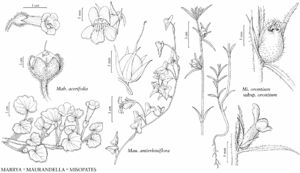Mabrya
Syst. Bot. Monogr. 5: 57, fig. 26. 1985.
| Taxon | Illustrator ⠉ | |
|---|---|---|
 | Mabrya acerifolia Maurandella antirrhiniflora Misopates orontium subsp. orontium | Barbara Alongi Barbara Alongi Barbara Alongi |
Herbs, perennial; caudex woody. Stems pendent [erect], glandular-hairy. Leaves cauline, alternate; petiole present; blade fleshy, not leathery, margins broadly dentate [crenate]. Inflorescences axillary, flowers solitary; bracts absent. Pedicels present; bracteoles absent. Flowers bisexual; sepals 5, basally connate, calyx radially symmetric, campanulate, lobes ovate; corolla ochroleucous to yellow [pink, red], bilaterally symmetric, bilabiate, tubular, tube base not spurred or gibbous, lobes 5, abaxial 3, adaxial 2; stamens 4, basally adnate to corolla, didynamous, filaments glandular-hairy; staminode 1, filamentous; ovary 2-locular, placentation axile; stigma 2-lobed. Fruits capsules, dehiscence loculicidal. Seeds 20–300, dark-brown [tan], oblong [ellipsoid, globular], wings absent [present]. x = 12.
Distribution
Ariz., n Mexico
Discussion
Species 5 (1 in the flora).
Mabrya is defined by several vegetative characteristics including pendent or erect, brittle stems, straight petioles, and glandular-hairy stems, leaves, and flowers. Species of Mabrya were placed previously in Maurandya Ortega by most authors; they have been recognized in Mabrya by W. J. Elisens (1985), D. A. Sutton (1988), and E. Fischer (2004). The phylogenetic relationships of Mabrya based on morphological characters are either unresolved (M. Ghebrehiwet et al. 2000) or poorly resolved (Elisens) because of character polymorphism and lack of synapomorphies for the genus. Molecular ITS data placed Holmgrenanthe in the Cymbalaria clade (M. Fernández-Mazuecos et al. 2013), in a subclade of seven genera that was sister to Asarina and Cymbalaria; Mabrya was sister to a node shared by Lophospermum and Maurandya.
Selected References
None.